Challenges of Primary Health Care Delivery in Older Patients: A Review
VerifiedAdded on 2023/01/12
|9
|2346
|34
Essay
AI Summary
This essay delves into the multifaceted challenges of primary healthcare delivery for older patients, examining the interplay of sociocultural factors, economic burdens, and healthcare budgets. It critiques the existing models of healthcare service delivery, evaluating the rationales behind resource allocation, service provision, and coordination of care. The essay emphasizes the need for a comprehensive care model that enhances patient outcomes and reduces the strain on administrative bodies. It further advocates for measures to balance healthcare costs and improve the quality of life for the elderly population, highlighting the significance of patient autonomy and community engagement in managing healthcare needs. The review also underscores the importance of a multidisciplinary approach and the role of health education in empowering older individuals to actively participate in their care, promoting integrated medicine and a framework of independence to reduce hospitalization and improve overall well-being.
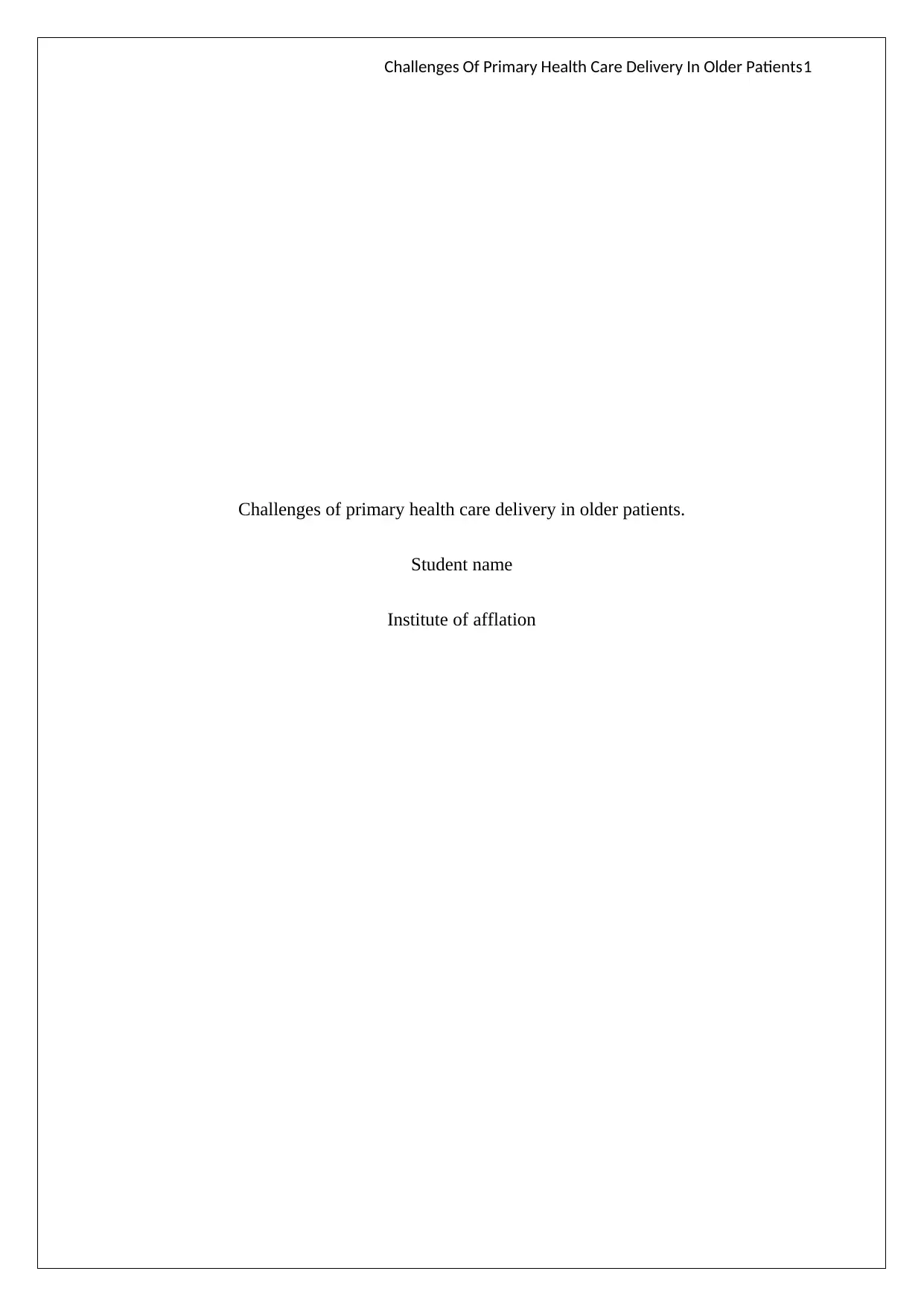
Challenges Of Primary Health Care Delivery In Older Patients1
Challenges of primary health care delivery in older patients.
Student name
Institute of afflation
Challenges of primary health care delivery in older patients.
Student name
Institute of afflation
Paraphrase This Document
Need a fresh take? Get an instant paraphrase of this document with our AI Paraphraser
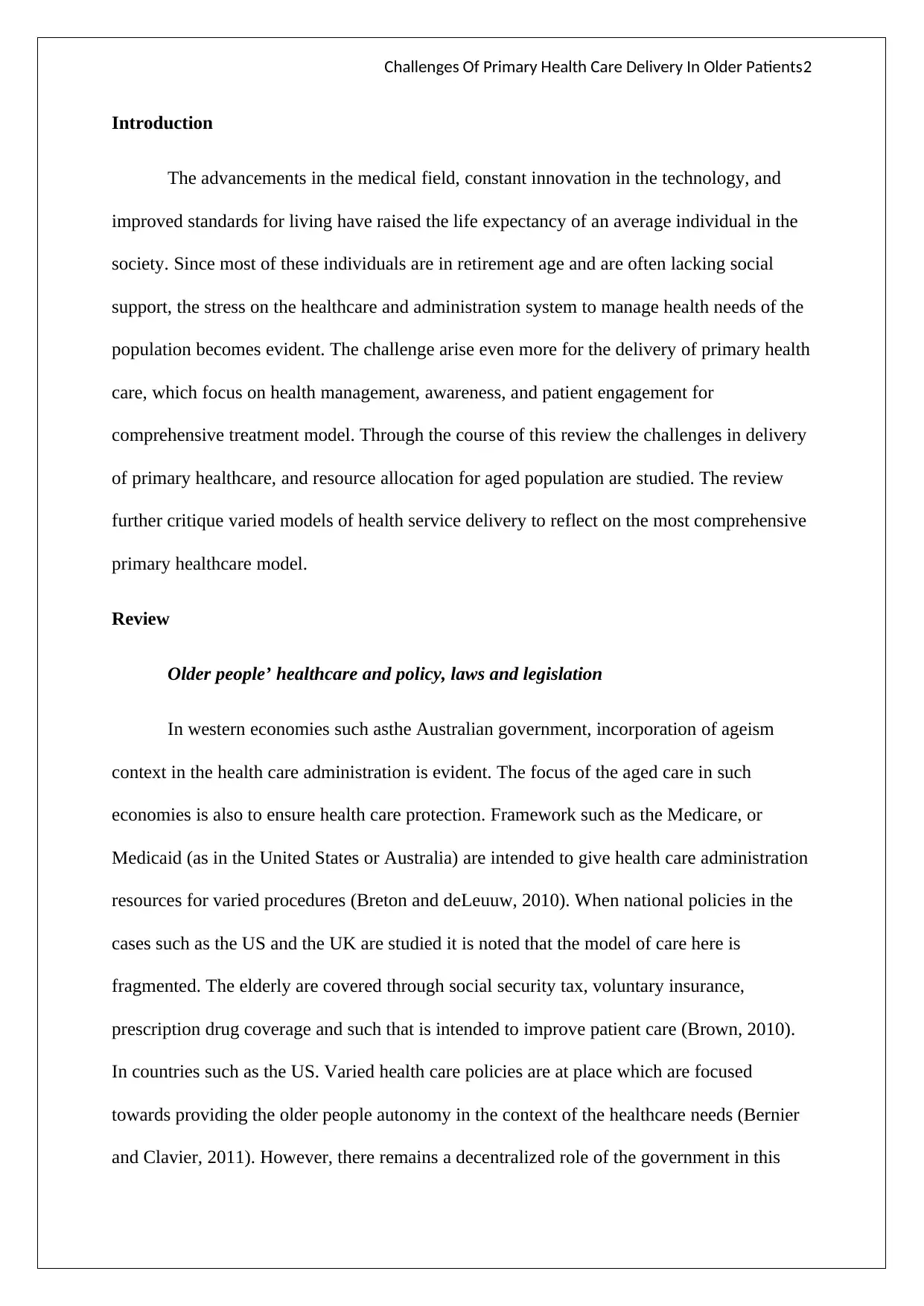
Challenges Of Primary Health Care Delivery In Older Patients2
Introduction
The advancements in the medical field, constant innovation in the technology, and
improved standards for living have raised the life expectancy of an average individual in the
society. Since most of these individuals are in retirement age and are often lacking social
support, the stress on the healthcare and administration system to manage health needs of the
population becomes evident. The challenge arise even more for the delivery of primary health
care, which focus on health management, awareness, and patient engagement for
comprehensive treatment model. Through the course of this review the challenges in delivery
of primary healthcare, and resource allocation for aged population are studied. The review
further critique varied models of health service delivery to reflect on the most comprehensive
primary healthcare model.
Review
Older people’ healthcare and policy, laws and legislation
In western economies such asthe Australian government, incorporation of ageism
context in the health care administration is evident. The focus of the aged care in such
economies is also to ensure health care protection. Framework such as the Medicare, or
Medicaid (as in the United States or Australia) are intended to give health care administration
resources for varied procedures (Breton and deLeuuw, 2010). When national policies in the
cases such as the US and the UK are studied it is noted that the model of care here is
fragmented. The elderly are covered through social security tax, voluntary insurance,
prescription drug coverage and such that is intended to improve patient care (Brown, 2010).
In countries such as the US. Varied health care policies are at place which are focused
towards providing the older people autonomy in the context of the healthcare needs (Bernier
and Clavier, 2011). However, there remains a decentralized role of the government in this
Introduction
The advancements in the medical field, constant innovation in the technology, and
improved standards for living have raised the life expectancy of an average individual in the
society. Since most of these individuals are in retirement age and are often lacking social
support, the stress on the healthcare and administration system to manage health needs of the
population becomes evident. The challenge arise even more for the delivery of primary health
care, which focus on health management, awareness, and patient engagement for
comprehensive treatment model. Through the course of this review the challenges in delivery
of primary healthcare, and resource allocation for aged population are studied. The review
further critique varied models of health service delivery to reflect on the most comprehensive
primary healthcare model.
Review
Older people’ healthcare and policy, laws and legislation
In western economies such asthe Australian government, incorporation of ageism
context in the health care administration is evident. The focus of the aged care in such
economies is also to ensure health care protection. Framework such as the Medicare, or
Medicaid (as in the United States or Australia) are intended to give health care administration
resources for varied procedures (Breton and deLeuuw, 2010). When national policies in the
cases such as the US and the UK are studied it is noted that the model of care here is
fragmented. The elderly are covered through social security tax, voluntary insurance,
prescription drug coverage and such that is intended to improve patient care (Brown, 2010).
In countries such as the US. Varied health care policies are at place which are focused
towards providing the older people autonomy in the context of the healthcare needs (Bernier
and Clavier, 2011). However, there remains a decentralized role of the government in this
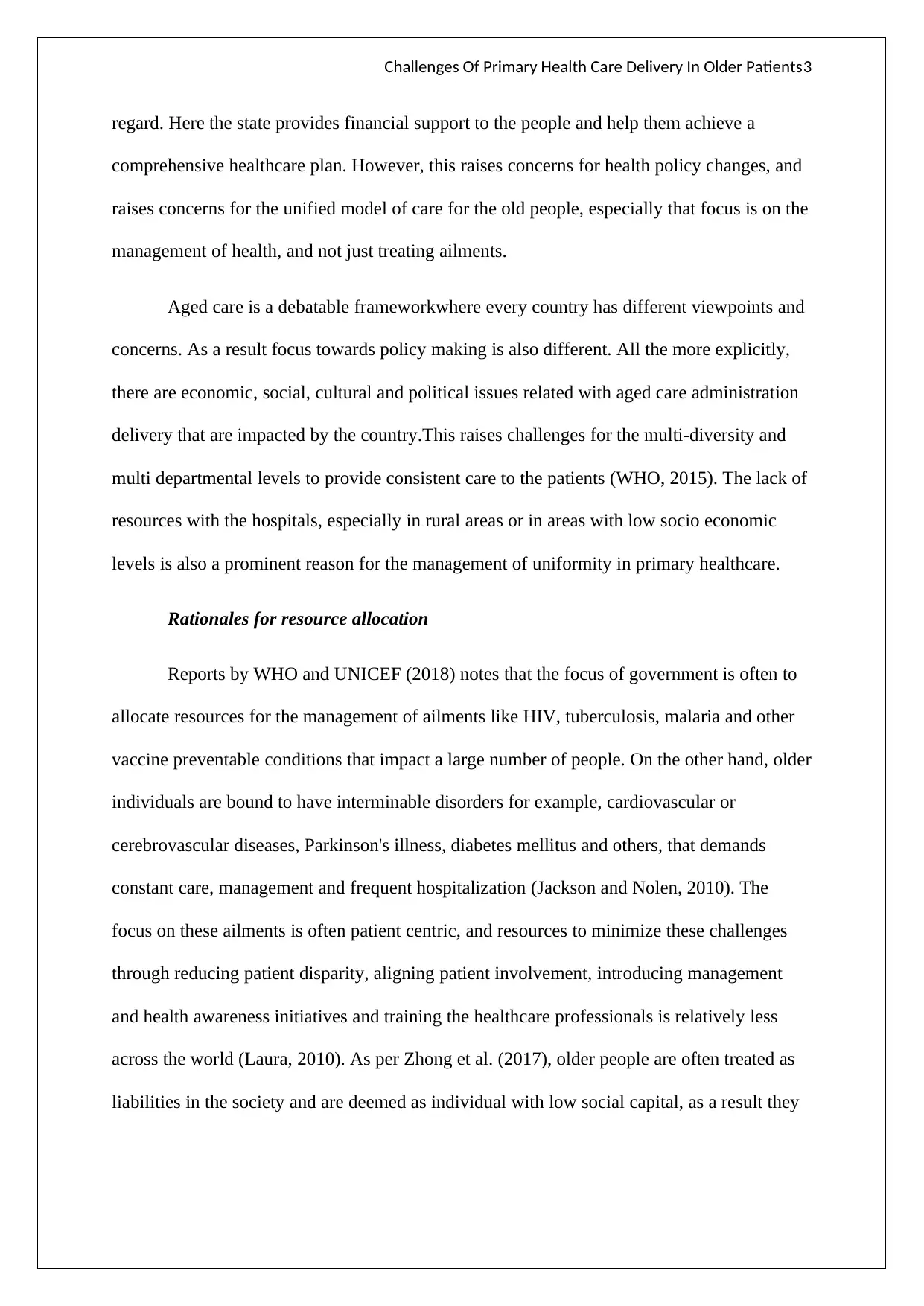
Challenges Of Primary Health Care Delivery In Older Patients3
regard. Here the state provides financial support to the people and help them achieve a
comprehensive healthcare plan. However, this raises concerns for health policy changes, and
raises concerns for the unified model of care for the old people, especially that focus is on the
management of health, and not just treating ailments.
Aged care is a debatable frameworkwhere every country has different viewpoints and
concerns. As a result focus towards policy making is also different. All the more explicitly,
there are economic, social, cultural and political issues related with aged care administration
delivery that are impacted by the country.This raises challenges for the multi-diversity and
multi departmental levels to provide consistent care to the patients (WHO, 2015). The lack of
resources with the hospitals, especially in rural areas or in areas with low socio economic
levels is also a prominent reason for the management of uniformity in primary healthcare.
Rationales for resource allocation
Reports by WHO and UNICEF (2018) notes that the focus of government is often to
allocate resources for the management of ailments like HIV, tuberculosis, malaria and other
vaccine preventable conditions that impact a large number of people. On the other hand, older
individuals are bound to have interminable disorders for example, cardiovascular or
cerebrovascular diseases, Parkinson's illness, diabetes mellitus and others, that demands
constant care, management and frequent hospitalization (Jackson and Nolen, 2010). The
focus on these ailments is often patient centric, and resources to minimize these challenges
through reducing patient disparity, aligning patient involvement, introducing management
and health awareness initiatives and training the healthcare professionals is relatively less
across the world (Laura, 2010). As per Zhong et al. (2017), older people are often treated as
liabilities in the society and are deemed as individual with low social capital, as a result they
regard. Here the state provides financial support to the people and help them achieve a
comprehensive healthcare plan. However, this raises concerns for health policy changes, and
raises concerns for the unified model of care for the old people, especially that focus is on the
management of health, and not just treating ailments.
Aged care is a debatable frameworkwhere every country has different viewpoints and
concerns. As a result focus towards policy making is also different. All the more explicitly,
there are economic, social, cultural and political issues related with aged care administration
delivery that are impacted by the country.This raises challenges for the multi-diversity and
multi departmental levels to provide consistent care to the patients (WHO, 2015). The lack of
resources with the hospitals, especially in rural areas or in areas with low socio economic
levels is also a prominent reason for the management of uniformity in primary healthcare.
Rationales for resource allocation
Reports by WHO and UNICEF (2018) notes that the focus of government is often to
allocate resources for the management of ailments like HIV, tuberculosis, malaria and other
vaccine preventable conditions that impact a large number of people. On the other hand, older
individuals are bound to have interminable disorders for example, cardiovascular or
cerebrovascular diseases, Parkinson's illness, diabetes mellitus and others, that demands
constant care, management and frequent hospitalization (Jackson and Nolen, 2010). The
focus on these ailments is often patient centric, and resources to minimize these challenges
through reducing patient disparity, aligning patient involvement, introducing management
and health awareness initiatives and training the healthcare professionals is relatively less
across the world (Laura, 2010). As per Zhong et al. (2017), older people are often treated as
liabilities in the society and are deemed as individual with low social capital, as a result they
⊘ This is a preview!⊘
Do you want full access?
Subscribe today to unlock all pages.

Trusted by 1+ million students worldwide
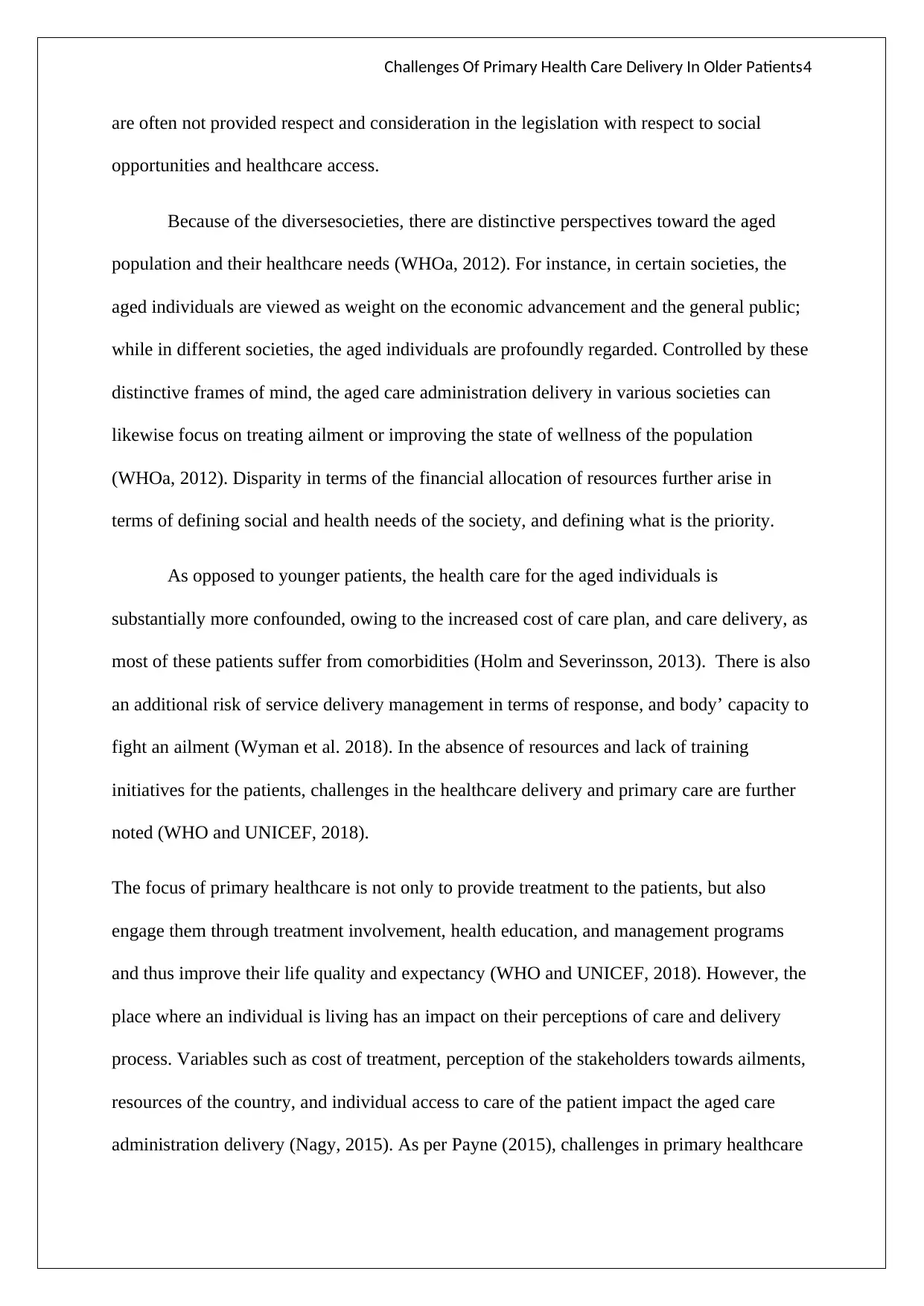
Challenges Of Primary Health Care Delivery In Older Patients4
are often not provided respect and consideration in the legislation with respect to social
opportunities and healthcare access.
Because of the diversesocieties, there are distinctive perspectives toward the aged
population and their healthcare needs (WHOa, 2012). For instance, in certain societies, the
aged individuals are viewed as weight on the economic advancement and the general public;
while in different societies, the aged individuals are profoundly regarded. Controlled by these
distinctive frames of mind, the aged care administration delivery in various societies can
likewise focus on treating ailment or improving the state of wellness of the population
(WHOa, 2012). Disparity in terms of the financial allocation of resources further arise in
terms of defining social and health needs of the society, and defining what is the priority.
As opposed to younger patients, the health care for the aged individuals is
substantially more confounded, owing to the increased cost of care plan, and care delivery, as
most of these patients suffer from comorbidities (Holm and Severinsson, 2013). There is also
an additional risk of service delivery management in terms of response, and body’ capacity to
fight an ailment (Wyman et al. 2018). In the absence of resources and lack of training
initiatives for the patients, challenges in the healthcare delivery and primary care are further
noted (WHO and UNICEF, 2018).
The focus of primary healthcare is not only to provide treatment to the patients, but also
engage them through treatment involvement, health education, and management programs
and thus improve their life quality and expectancy (WHO and UNICEF, 2018). However, the
place where an individual is living has an impact on their perceptions of care and delivery
process. Variables such as cost of treatment, perception of the stakeholders towards ailments,
resources of the country, and individual access to care of the patient impact the aged care
administration delivery (Nagy, 2015). As per Payne (2015), challenges in primary healthcare
are often not provided respect and consideration in the legislation with respect to social
opportunities and healthcare access.
Because of the diversesocieties, there are distinctive perspectives toward the aged
population and their healthcare needs (WHOa, 2012). For instance, in certain societies, the
aged individuals are viewed as weight on the economic advancement and the general public;
while in different societies, the aged individuals are profoundly regarded. Controlled by these
distinctive frames of mind, the aged care administration delivery in various societies can
likewise focus on treating ailment or improving the state of wellness of the population
(WHOa, 2012). Disparity in terms of the financial allocation of resources further arise in
terms of defining social and health needs of the society, and defining what is the priority.
As opposed to younger patients, the health care for the aged individuals is
substantially more confounded, owing to the increased cost of care plan, and care delivery, as
most of these patients suffer from comorbidities (Holm and Severinsson, 2013). There is also
an additional risk of service delivery management in terms of response, and body’ capacity to
fight an ailment (Wyman et al. 2018). In the absence of resources and lack of training
initiatives for the patients, challenges in the healthcare delivery and primary care are further
noted (WHO and UNICEF, 2018).
The focus of primary healthcare is not only to provide treatment to the patients, but also
engage them through treatment involvement, health education, and management programs
and thus improve their life quality and expectancy (WHO and UNICEF, 2018). However, the
place where an individual is living has an impact on their perceptions of care and delivery
process. Variables such as cost of treatment, perception of the stakeholders towards ailments,
resources of the country, and individual access to care of the patient impact the aged care
administration delivery (Nagy, 2015). As per Payne (2015), challenges in primary healthcare
Paraphrase This Document
Need a fresh take? Get an instant paraphrase of this document with our AI Paraphraser
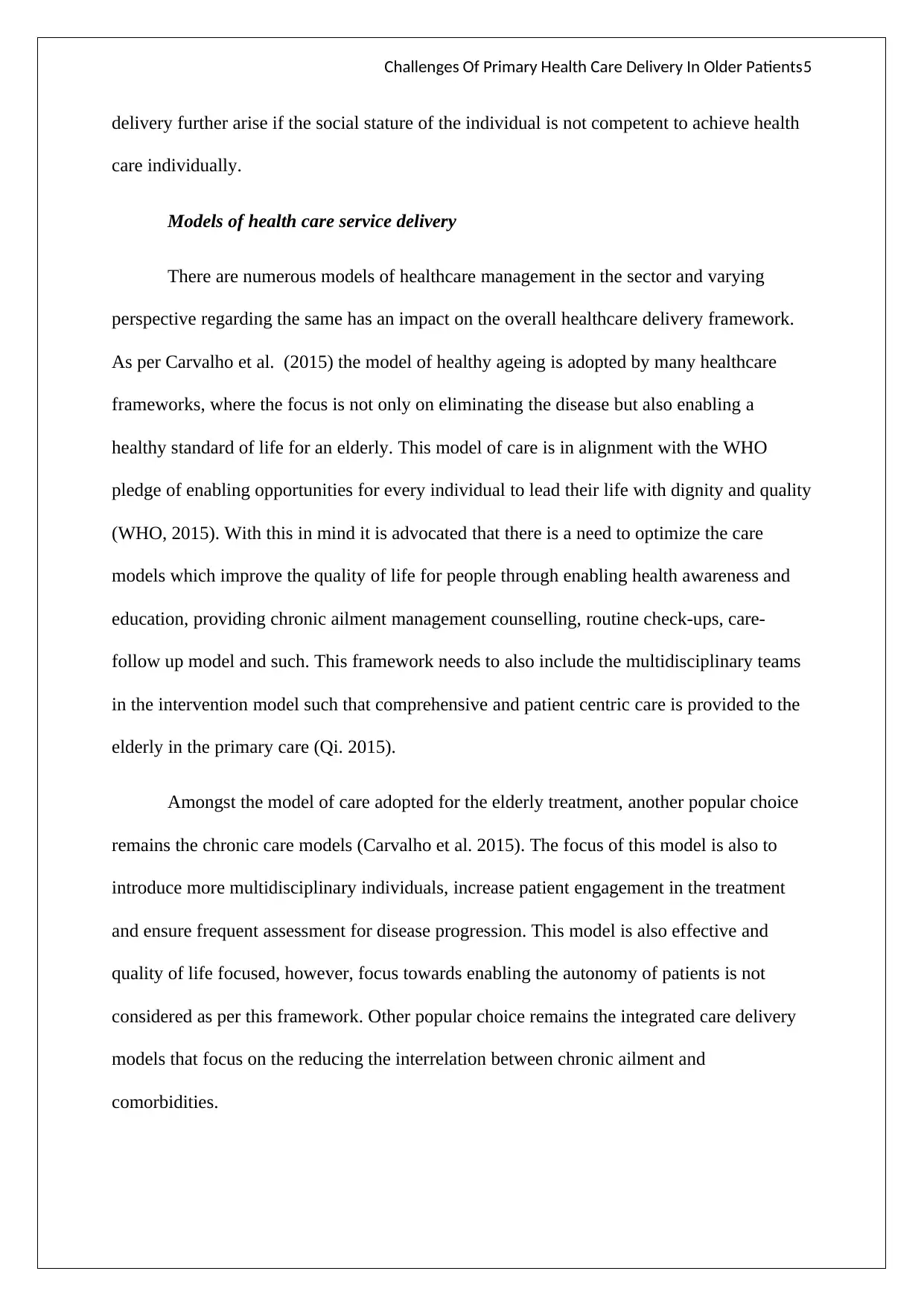
Challenges Of Primary Health Care Delivery In Older Patients5
delivery further arise if the social stature of the individual is not competent to achieve health
care individually.
Models of health care service delivery
There are numerous models of healthcare management in the sector and varying
perspective regarding the same has an impact on the overall healthcare delivery framework.
As per Carvalho et al. (2015) the model of healthy ageing is adopted by many healthcare
frameworks, where the focus is not only on eliminating the disease but also enabling a
healthy standard of life for an elderly. This model of care is in alignment with the WHO
pledge of enabling opportunities for every individual to lead their life with dignity and quality
(WHO, 2015). With this in mind it is advocated that there is a need to optimize the care
models which improve the quality of life for people through enabling health awareness and
education, providing chronic ailment management counselling, routine check-ups, care-
follow up model and such. This framework needs to also include the multidisciplinary teams
in the intervention model such that comprehensive and patient centric care is provided to the
elderly in the primary care (Qi. 2015).
Amongst the model of care adopted for the elderly treatment, another popular choice
remains the chronic care models (Carvalho et al. 2015). The focus of this model is also to
introduce more multidisciplinary individuals, increase patient engagement in the treatment
and ensure frequent assessment for disease progression. This model is also effective and
quality of life focused, however, focus towards enabling the autonomy of patients is not
considered as per this framework. Other popular choice remains the integrated care delivery
models that focus on the reducing the interrelation between chronic ailment and
comorbidities.
delivery further arise if the social stature of the individual is not competent to achieve health
care individually.
Models of health care service delivery
There are numerous models of healthcare management in the sector and varying
perspective regarding the same has an impact on the overall healthcare delivery framework.
As per Carvalho et al. (2015) the model of healthy ageing is adopted by many healthcare
frameworks, where the focus is not only on eliminating the disease but also enabling a
healthy standard of life for an elderly. This model of care is in alignment with the WHO
pledge of enabling opportunities for every individual to lead their life with dignity and quality
(WHO, 2015). With this in mind it is advocated that there is a need to optimize the care
models which improve the quality of life for people through enabling health awareness and
education, providing chronic ailment management counselling, routine check-ups, care-
follow up model and such. This framework needs to also include the multidisciplinary teams
in the intervention model such that comprehensive and patient centric care is provided to the
elderly in the primary care (Qi. 2015).
Amongst the model of care adopted for the elderly treatment, another popular choice
remains the chronic care models (Carvalho et al. 2015). The focus of this model is also to
introduce more multidisciplinary individuals, increase patient engagement in the treatment
and ensure frequent assessment for disease progression. This model is also effective and
quality of life focused, however, focus towards enabling the autonomy of patients is not
considered as per this framework. Other popular choice remains the integrated care delivery
models that focus on the reducing the interrelation between chronic ailment and
comorbidities.
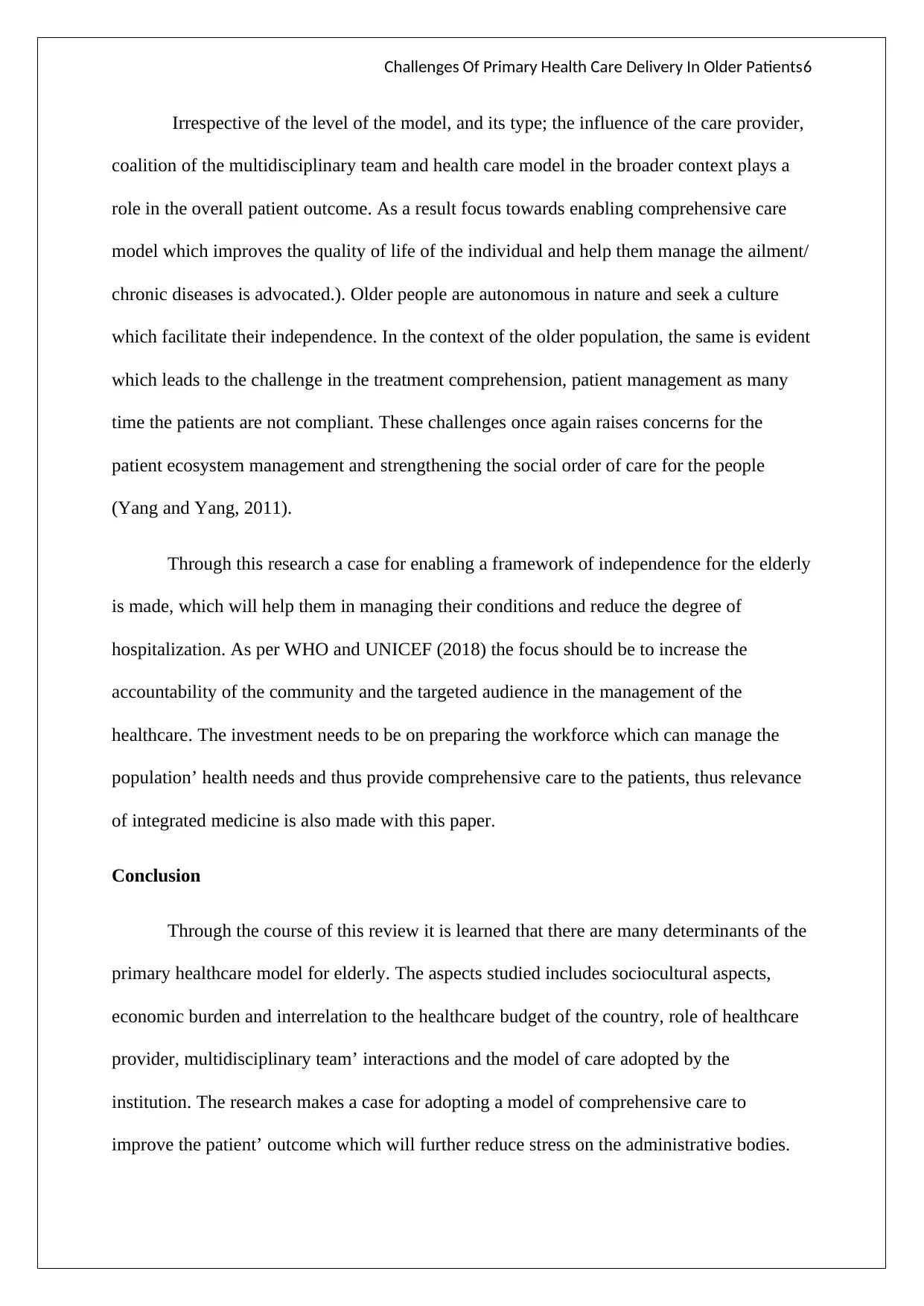
Challenges Of Primary Health Care Delivery In Older Patients6
Irrespective of the level of the model, and its type; the influence of the care provider,
coalition of the multidisciplinary team and health care model in the broader context plays a
role in the overall patient outcome. As a result focus towards enabling comprehensive care
model which improves the quality of life of the individual and help them manage the ailment/
chronic diseases is advocated.). Older people are autonomous in nature and seek a culture
which facilitate their independence. In the context of the older population, the same is evident
which leads to the challenge in the treatment comprehension, patient management as many
time the patients are not compliant. These challenges once again raises concerns for the
patient ecosystem management and strengthening the social order of care for the people
(Yang and Yang, 2011).
Through this research a case for enabling a framework of independence for the elderly
is made, which will help them in managing their conditions and reduce the degree of
hospitalization. As per WHO and UNICEF (2018) the focus should be to increase the
accountability of the community and the targeted audience in the management of the
healthcare. The investment needs to be on preparing the workforce which can manage the
population’ health needs and thus provide comprehensive care to the patients, thus relevance
of integrated medicine is also made with this paper.
Conclusion
Through the course of this review it is learned that there are many determinants of the
primary healthcare model for elderly. The aspects studied includes sociocultural aspects,
economic burden and interrelation to the healthcare budget of the country, role of healthcare
provider, multidisciplinary team’ interactions and the model of care adopted by the
institution. The research makes a case for adopting a model of comprehensive care to
improve the patient’ outcome which will further reduce stress on the administrative bodies.
Irrespective of the level of the model, and its type; the influence of the care provider,
coalition of the multidisciplinary team and health care model in the broader context plays a
role in the overall patient outcome. As a result focus towards enabling comprehensive care
model which improves the quality of life of the individual and help them manage the ailment/
chronic diseases is advocated.). Older people are autonomous in nature and seek a culture
which facilitate their independence. In the context of the older population, the same is evident
which leads to the challenge in the treatment comprehension, patient management as many
time the patients are not compliant. These challenges once again raises concerns for the
patient ecosystem management and strengthening the social order of care for the people
(Yang and Yang, 2011).
Through this research a case for enabling a framework of independence for the elderly
is made, which will help them in managing their conditions and reduce the degree of
hospitalization. As per WHO and UNICEF (2018) the focus should be to increase the
accountability of the community and the targeted audience in the management of the
healthcare. The investment needs to be on preparing the workforce which can manage the
population’ health needs and thus provide comprehensive care to the patients, thus relevance
of integrated medicine is also made with this paper.
Conclusion
Through the course of this review it is learned that there are many determinants of the
primary healthcare model for elderly. The aspects studied includes sociocultural aspects,
economic burden and interrelation to the healthcare budget of the country, role of healthcare
provider, multidisciplinary team’ interactions and the model of care adopted by the
institution. The research makes a case for adopting a model of comprehensive care to
improve the patient’ outcome which will further reduce stress on the administrative bodies.
⊘ This is a preview!⊘
Do you want full access?
Subscribe today to unlock all pages.

Trusted by 1+ million students worldwide
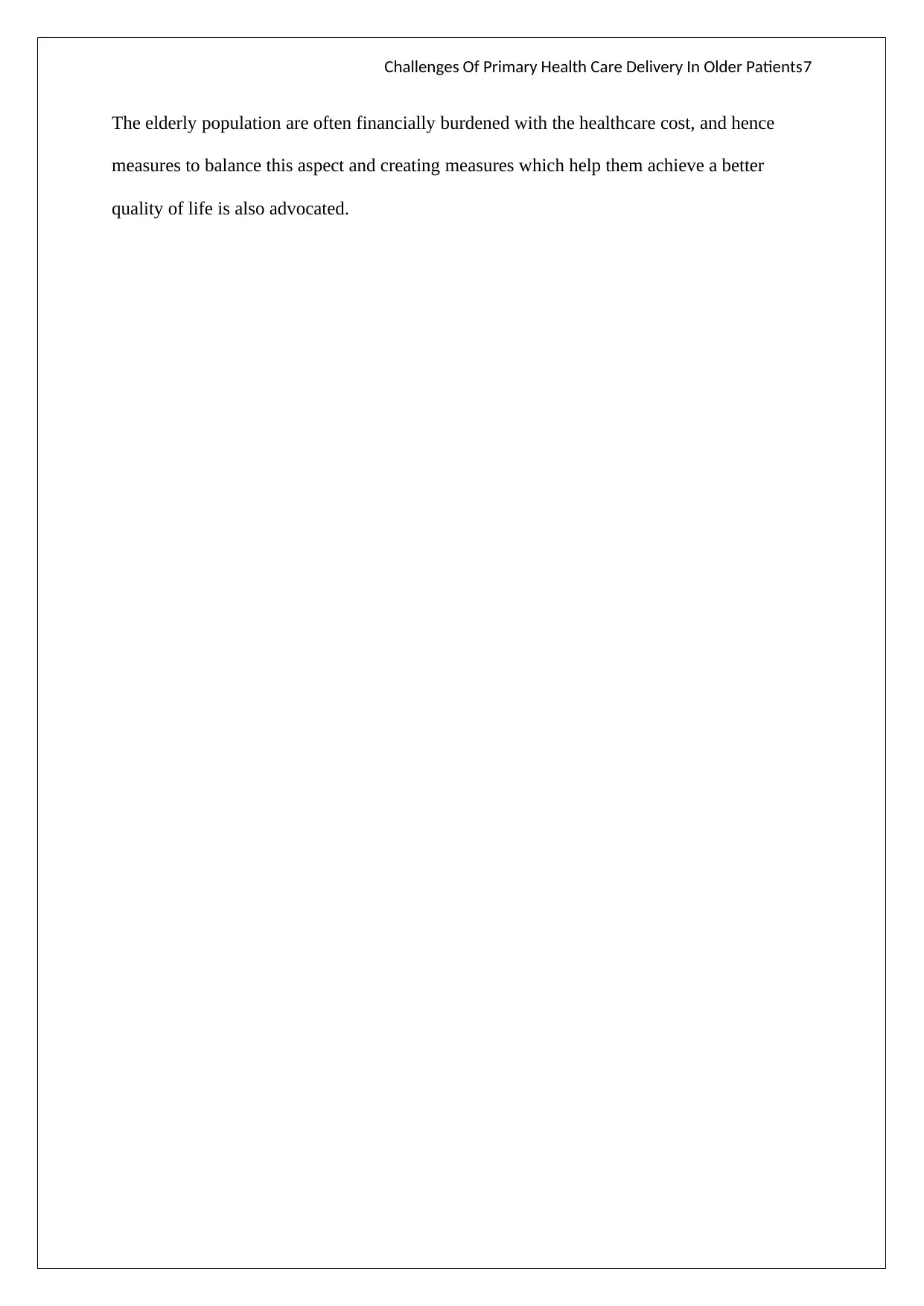
Challenges Of Primary Health Care Delivery In Older Patients7
The elderly population are often financially burdened with the healthcare cost, and hence
measures to balance this aspect and creating measures which help them achieve a better
quality of life is also advocated.
The elderly population are often financially burdened with the healthcare cost, and hence
measures to balance this aspect and creating measures which help them achieve a better
quality of life is also advocated.
Paraphrase This Document
Need a fresh take? Get an instant paraphrase of this document with our AI Paraphraser
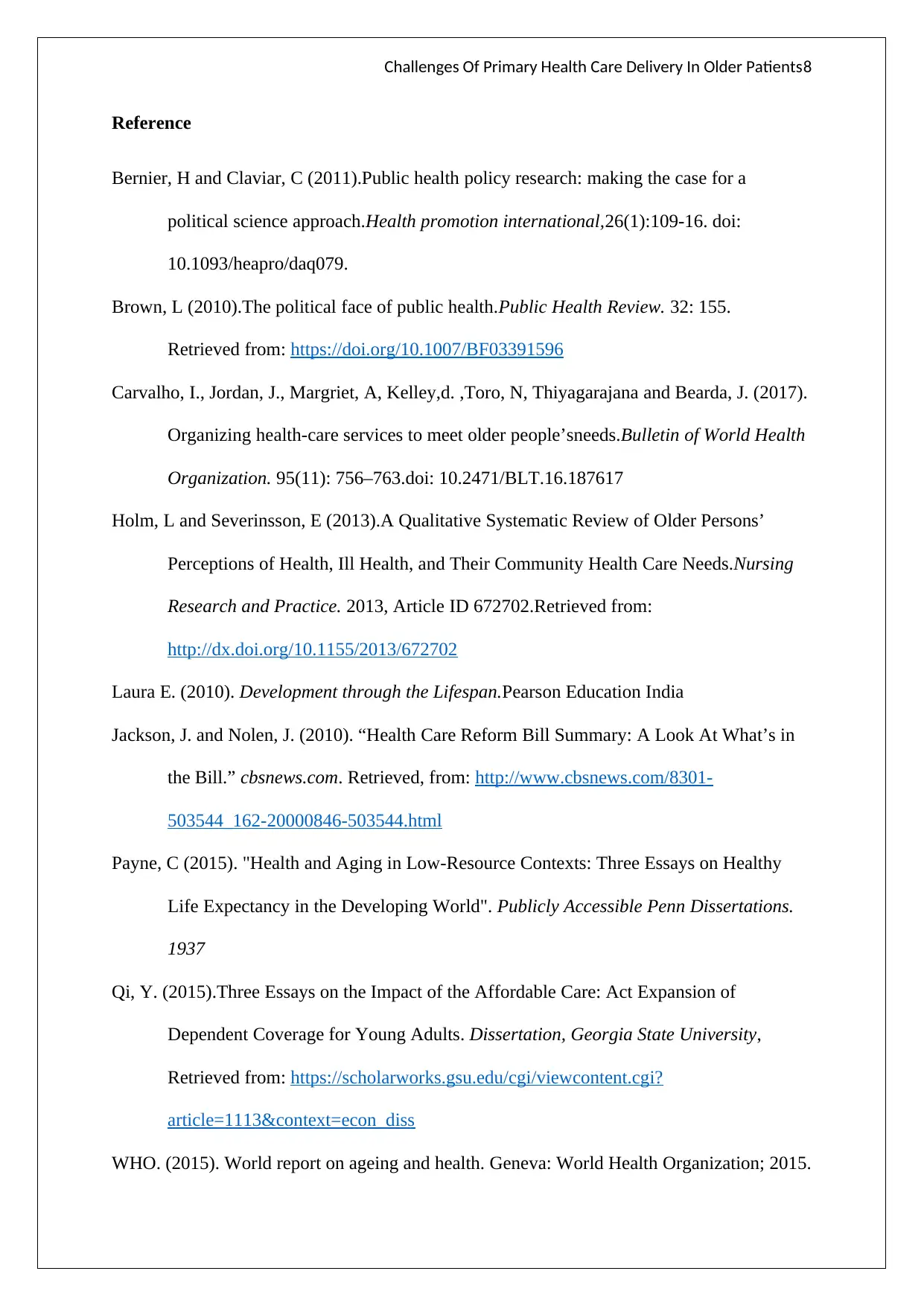
Challenges Of Primary Health Care Delivery In Older Patients8
Reference
Bernier, H and Claviar, C (2011).Public health policy research: making the case for a
political science approach.Health promotion international,26(1):109-16. doi:
10.1093/heapro/daq079.
Brown, L (2010).The political face of public health.Public Health Review. 32: 155.
Retrieved from: https://doi.org/10.1007/BF03391596
Carvalho, I., Jordan, J., Margriet, A, Kelley,d. ,Toro, N, Thiyagarajana and Bearda, J. (2017).
Organizing health-care services to meet older people’sneeds.Bulletin of World Health
Organization. 95(11): 756–763.doi: 10.2471/BLT.16.187617
Holm, L and Severinsson, E (2013).A Qualitative Systematic Review of Older Persons’
Perceptions of Health, Ill Health, and Their Community Health Care Needs.Nursing
Research and Practice. 2013, Article ID 672702.Retrieved from:
http://dx.doi.org/10.1155/2013/672702
Laura E. (2010). Development through the Lifespan.Pearson Education India
Jackson, J. and Nolen, J. (2010). “Health Care Reform Bill Summary: A Look At What’s in
the Bill.” cbsnews.com. Retrieved, from: http://www.cbsnews.com/8301-
503544_162-20000846-503544.html
Payne, C (2015). "Health and Aging in Low-Resource Contexts: Three Essays on Healthy
Life Expectancy in the Developing World". Publicly Accessible Penn Dissertations.
1937
Qi, Y. (2015).Three Essays on the Impact of the Affordable Care: Act Expansion of
Dependent Coverage for Young Adults. Dissertation, Georgia State University,
Retrieved from: https://scholarworks.gsu.edu/cgi/viewcontent.cgi?
article=1113&context=econ_diss
WHO. (2015). World report on ageing and health. Geneva: World Health Organization; 2015.
Reference
Bernier, H and Claviar, C (2011).Public health policy research: making the case for a
political science approach.Health promotion international,26(1):109-16. doi:
10.1093/heapro/daq079.
Brown, L (2010).The political face of public health.Public Health Review. 32: 155.
Retrieved from: https://doi.org/10.1007/BF03391596
Carvalho, I., Jordan, J., Margriet, A, Kelley,d. ,Toro, N, Thiyagarajana and Bearda, J. (2017).
Organizing health-care services to meet older people’sneeds.Bulletin of World Health
Organization. 95(11): 756–763.doi: 10.2471/BLT.16.187617
Holm, L and Severinsson, E (2013).A Qualitative Systematic Review of Older Persons’
Perceptions of Health, Ill Health, and Their Community Health Care Needs.Nursing
Research and Practice. 2013, Article ID 672702.Retrieved from:
http://dx.doi.org/10.1155/2013/672702
Laura E. (2010). Development through the Lifespan.Pearson Education India
Jackson, J. and Nolen, J. (2010). “Health Care Reform Bill Summary: A Look At What’s in
the Bill.” cbsnews.com. Retrieved, from: http://www.cbsnews.com/8301-
503544_162-20000846-503544.html
Payne, C (2015). "Health and Aging in Low-Resource Contexts: Three Essays on Healthy
Life Expectancy in the Developing World". Publicly Accessible Penn Dissertations.
1937
Qi, Y. (2015).Three Essays on the Impact of the Affordable Care: Act Expansion of
Dependent Coverage for Young Adults. Dissertation, Georgia State University,
Retrieved from: https://scholarworks.gsu.edu/cgi/viewcontent.cgi?
article=1113&context=econ_diss
WHO. (2015). World report on ageing and health. Geneva: World Health Organization; 2015.
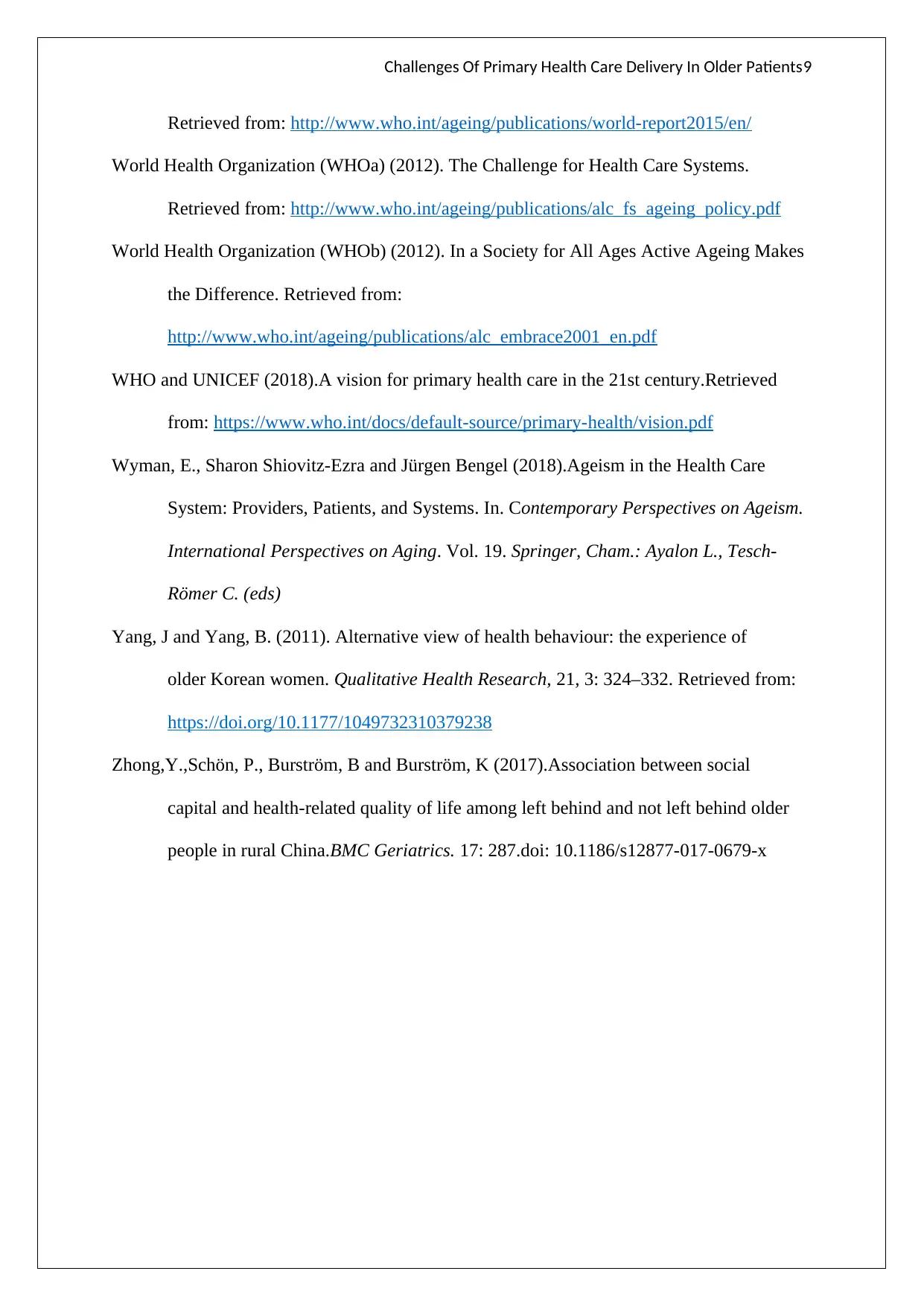
Challenges Of Primary Health Care Delivery In Older Patients9
Retrieved from: http://www.who.int/ageing/publications/world-report2015/en/
World Health Organization (WHOa) (2012). The Challenge for Health Care Systems.
Retrieved from: http://www.who.int/ageing/publications/alc_fs_ageing_policy.pdf
World Health Organization (WHOb) (2012). In a Society for All Ages Active Ageing Makes
the Difference. Retrieved from:
http://www.who.int/ageing/publications/alc_embrace2001_en.pdf
WHO and UNICEF (2018).A vision for primary health care in the 21st century.Retrieved
from: https://www.who.int/docs/default-source/primary-health/vision.pdf
Wyman, E., Sharon Shiovitz-Ezra and Jürgen Bengel (2018).Ageism in the Health Care
System: Providers, Patients, and Systems. In. Contemporary Perspectives on Ageism.
International Perspectives on Aging. Vol. 19. Springer, Cham.: Ayalon L., Tesch-
Römer C. (eds)
Yang, J and Yang, B. (2011). Alternative view of health behaviour: the experience of
older Korean women. Qualitative Health Research, 21, 3: 324–332. Retrieved from:
https://doi.org/10.1177/1049732310379238
Zhong,Y.,Schön, P., Burström, B and Burström, K (2017).Association between social
capital and health-related quality of life among left behind and not left behind older
people in rural China.BMC Geriatrics. 17: 287.doi: 10.1186/s12877-017-0679-x
Retrieved from: http://www.who.int/ageing/publications/world-report2015/en/
World Health Organization (WHOa) (2012). The Challenge for Health Care Systems.
Retrieved from: http://www.who.int/ageing/publications/alc_fs_ageing_policy.pdf
World Health Organization (WHOb) (2012). In a Society for All Ages Active Ageing Makes
the Difference. Retrieved from:
http://www.who.int/ageing/publications/alc_embrace2001_en.pdf
WHO and UNICEF (2018).A vision for primary health care in the 21st century.Retrieved
from: https://www.who.int/docs/default-source/primary-health/vision.pdf
Wyman, E., Sharon Shiovitz-Ezra and Jürgen Bengel (2018).Ageism in the Health Care
System: Providers, Patients, and Systems. In. Contemporary Perspectives on Ageism.
International Perspectives on Aging. Vol. 19. Springer, Cham.: Ayalon L., Tesch-
Römer C. (eds)
Yang, J and Yang, B. (2011). Alternative view of health behaviour: the experience of
older Korean women. Qualitative Health Research, 21, 3: 324–332. Retrieved from:
https://doi.org/10.1177/1049732310379238
Zhong,Y.,Schön, P., Burström, B and Burström, K (2017).Association between social
capital and health-related quality of life among left behind and not left behind older
people in rural China.BMC Geriatrics. 17: 287.doi: 10.1186/s12877-017-0679-x
⊘ This is a preview!⊘
Do you want full access?
Subscribe today to unlock all pages.

Trusted by 1+ million students worldwide
1 out of 9
Related Documents
Your All-in-One AI-Powered Toolkit for Academic Success.
+13062052269
info@desklib.com
Available 24*7 on WhatsApp / Email
![[object Object]](/_next/static/media/star-bottom.7253800d.svg)
Unlock your academic potential
Copyright © 2020–2025 A2Z Services. All Rights Reserved. Developed and managed by ZUCOL.





